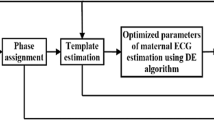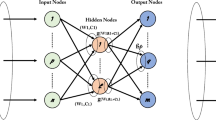Abstract
Extraction of fetal electrocardiogram (FECG) from the abdominal region of the mother’s skin is challenge task due to the high overlapping of maternal and fetal signals in this area. To overcome the problem, this paper proposes the utilization of extreme learning model (ELM) as the prediction algorithm to train on the FECG signal extracted by least mean square approach from the input abdominal and thoracic signals. The trained ELM model is used to model the FECG signal for the testing samples. Also, this paper investigates the firefly algorithm (FA) to tune the parameters of ELM and improve its performance. Due to the high complexity and too many parameters of FA, this paper embeds the evolutionary scheme into the FA algorithm which benefits from adaptive crossover and mutation probabilities. Evaluation of the proposed method on both synthetic and actual datasets proves its qualification in FECG extraction and modeling.












Similar content being viewed by others
References
Assaleh, K. (2007). Extraction of fetal electrocardiogram using adaptive neuro-fuzzy inference systems. IEEE Transactions on Biomedical Engineering,54(1), 59–68.
Camps-Valls, G., Martínez-Sober, M., Soria-Olivas, E., MagdalenaBenedito, R., Calpe-Maravilla, J., & Guerrero-Martínez, J. (2004). Foetal ECG recovery using dynamic neural networks. Artificial Intelligence in Medicine,31(3), 197–209.
Cardoso, J. F. (Ed.). (1998). Multidimensional independent component analysis. In IEEE international conference on acoustics, speech, and signal processing (ICASSP’98).
Dixit, S., & Nagaria, D. (2017). Design and analysis of cascaded LMS adaptive filters for noise cancellation. Circuits, Systems, and Signal Processing,36(2), 742–766.
Igneron, V., Paraschiv-Ionescu, A., Azancot, A., Sibony, O., & Jutten, C. (Eds.). (2003). Fetal electrocardiogram extraction based on non-stationary ICA and wavelet denoising. In International synposum on signal processing and its applications.
Jafari, M. G., & Chambers, J. A. (2005). Fetal electrocardiogram extraction by sequential source separation in the wavelet domain. IEEE Transactions on Biomedical Engineering,52, 390–400.
Lathauwer, L. (2008). Database for the Identification of Systems: FECG data EAST/SISTA K.U. Leuven, Belgium [Online]. http://www.esat.kuleuven.ac.be/sista/daisy/. Accessed 22 Sept 2017.
Lathauwer, L. D., Moor, B. D., & Vandewalle, J. (2000). Fetal electrocardiogram extraction by blind source subspace separation. IEEE Transaction on Biomedical Engineering,47, 567–572.
Martin-Clemente, R., Camargo-Olivares, J. L., Hornillo-Mellado, S., Elena, M., & Roman, I. (2011). Fast technique for noninvasive fetal ECG extraction. IEEE Transactions on Biomedical Engineering,58, 227–230.
Marzbanrad, F., Kimura, Y., Funamoto, K., Sugibayashi, R., Endo, M., Ito, T., et al. (2014). Automated estimation of fetal cardiac timing events from doppler ultrasound signal using hybrid models. IEEE Journal of Biomedical and Health Informatics,18(4), 1169–1177.
McSharry, P., Clifford, G., Tarassenko, L., & Smith, L. (2003). A dynamical model for generating synthetic electrocardiogram signals. IEEE Transactions on Biomedical Engineering,50(3), 289–294.
Safdar, S., Zafar, S., Zafar, N., & Khan, N. F. (2017). Machine learning based decision support systems (DSS) for heart disease diagnosis: A review. Artificial Intelligence Review. https://doi.org/10.1007/s10462-017-9552-8.
Sameni, R. (2008). Extraction of fetal cardiac signals from an array of maternal abdominal recordings. Ph.D. Disseration, Department of Electrical and Computer Engineering, Sharif University of Technology, Tehran, Iran.
Sameni, R., & Clifford, G. D. (2010). A review of fetal ECG signal processing; issues and promising directions. The Open Pacing Electrophysiology & Therapy Journal (TOPETJ),3, 4–20.
Spilka, J., Frecon, J., Leonarduzzi, R., Pustelnik, N., Abry, P., & Doret, M. (2017). Sparse support vector machine for intrapartum fetal heart rate classification. IEEE Journal of Biomedical and Health Informatics,21(3), 664–671.
Sutha, P., & Jayanthi, V. E. (2018). Fetal electrocardiogram extraction and analysis using adaptive noise cancellation and wavelet transformation techniques. Journal of Medical Systems,42(1), 21.
Wang, H., Wang, W., Zhou, X., Sun, H., Zhao, J., Yu, X., et al. (2017). Firefly algorithm with neighborhood attraction. Information Sciences,382, 374–387.
Yang, X. S., & He, X. (2013). Firefly algorithm: Recent advances and applications. International Journal of Swarm Intelligence,1(1), 36–50.
Zarzoso, V., & Nandi, A. K. (2001). Noninvasive fetal electrocardiogram extraction: Blind separation versus adaptive noise cancellation. IEEE Transactions on Biomedical Engineering,48, 12–18.
Zhang, L., & Zhang, D. (2017). Evolutionary cost-sensitive extreme learning machine. IEEE Transactions on Neural Networks and Learning Systems,28(12), 3045–3060.
Author information
Authors and Affiliations
Corresponding author
Additional information
Publisher's Note
Springer Nature remains neutral with regard to jurisdictional claims in published maps and institutional affiliations.
Rights and permissions
About this article
Cite this article
Akhavan-Amjadi, M. Fetal electrocardiogram modeling using hybrid evolutionary firefly algorithm and extreme learning machine. Multidim Syst Sign Process 31, 117–133 (2020). https://doi.org/10.1007/s11045-019-00653-8
Received:
Revised:
Accepted:
Published:
Issue Date:
DOI: https://doi.org/10.1007/s11045-019-00653-8




